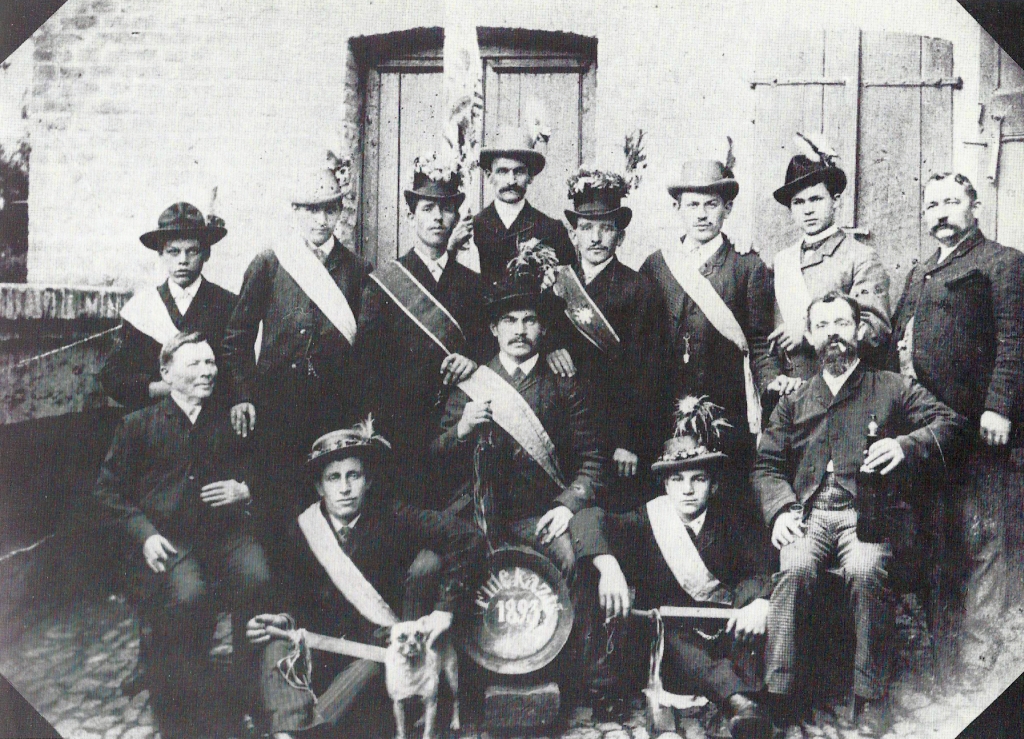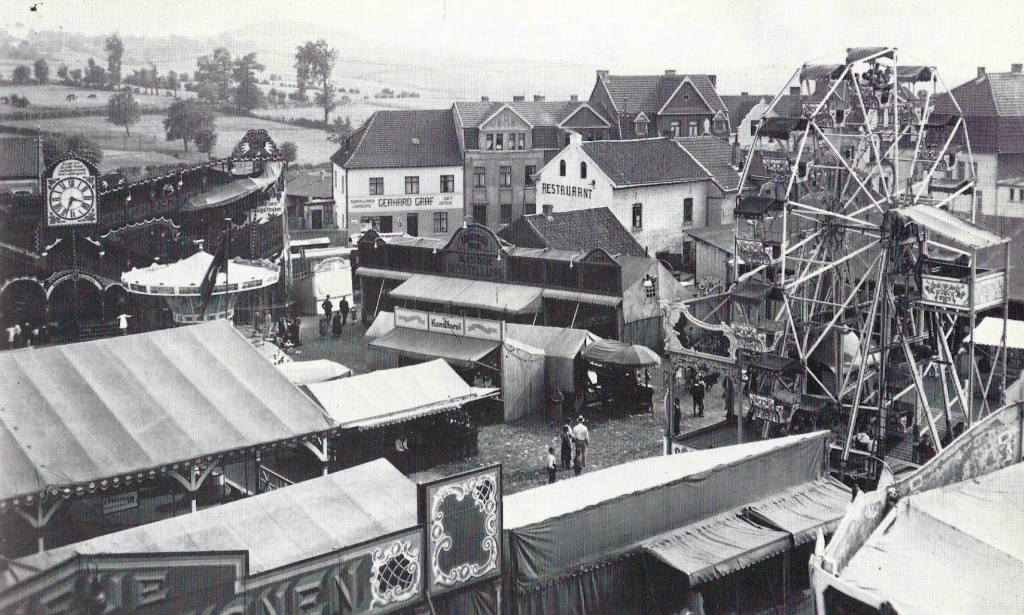Page 203 to 204 - Normally we are pretty sure that we can write at least 'Denglish' which means that the English is rather bad but a kind person will understand the clue. Here, with the May Customs, we not really sure ...
May customs and Jungenspiel in Würselen
The history of the ‘Maibräuche’ (May Customs) and the Jungenspiele in our city is several centuries old. However, it is no longer possible to pinpoint exactly when exactly all this started.
Looking back in history
Home researchers and historians of our region had found evidence of such customs around the 13th and 14th centuries. The Maibräuche changed only in such a way, that we can just see the roots of our current customs.
Homeland researcher Dr. Oellers in 1913: „In the 13th and 14th centuries, the competition between summer and winter replaced something completely new: The bringing in and planting of the May tree, which was supposed to represent the symbol of fertility and health, and which was not, as is the case today, a high slim fir, but a stately birch. This was solemnly taken from the forest under singing and riding dances, with bathsathers and flowers cleaned up, then carried in procession from house to house and finally planted in the main square of the village. After this solemn ceremony, the games where young and old participated in exuberant mood.“
Dr. Schiffers, a historian, cites the year 1224 as the time of the first mention of a May tree set in Aachen. This had been noted by a monk who „A pious and educated man“ reported how in Aachen on the behave of the pastor „the tree and other wreaths had to be cut off“. The “Vogt” however ordered the city „Soon to lift up an even higher tree.“
Aachen Council Protocols
In the 17th and 18th centuries we can follow the tracks of the May customs in Aachen and the villages of Würselen (Aachen Empire). The minutes of 10 June 1661 meeting of the Aachen Council reads:
„Meyspiel. zufolg E.E. Raths voriger Uberkömbsten sollen alle Meispiell und Dantzen uff ofnen straßen und andere exorbitantien mit schießen und Maysetzen verbotten sein, und solches sowoll in der Statt alls im gebith Aach notificirt werden unter straff von 3 goltguld.“
(The meaning: All May games are not permitted. No dancing in the streets, no shooting, no tree-setting. This should hold for the city of Aachen and the neighborhood. Any violation will be fined with 3 guldens.)
The 19th century
The tradition continued, of course. However, the customs changed then as they do today. In the 1928 book of the city of Würselen, the hometown scholar Karl Corsten mentions the prohibition of the ‘Maisingen’ by Prussian officials. Nevertheless, little stories prove that the people in Würselener did not obey this ban.
Then policemen were misled or even imprisoned, and “meanwhile, the May customs had been going on outside, and at the end they had settled in groups for the usual egg cake dinner and had gathered for a cozy drink. “The Chronicle of the Mayor” also contains references to this ancient custom, circa 1865:
„On the night of May 6th to the 7th, several young people from different villages in the community came together to make the ancient flimflam with these May-Marriage-Declarartions.“
How it used to be
Once again, Karl Corsten is to be quoted with part of his essay on the hometown book of the city of Würselen (1928), in which he describes the Jungenspiele (youth games) at the turn of the century in the 20th century:
„It isn’t really worth at the end of the day to talk about the Jungenspiele as they are an old custom here. Today, we are again really proud of the political agreement of the scattered villages Oppen, Haal, Drisch, Dobach, Grevenberg, Scherberg, Elchenrath, Morsbach with all its interesting hallway names to a municipal administrative unit of the city of Würselen. (Karl Corsten forgot Schweilbach, Bissen and Neuhaus in this list. I am sure that his remarks will apply to all Würselen districts and villages. Just to note, The author)
At that time, the aforementioned parts of the village led a much more self-soured life with a tradition-grown, rich-differentiated and emotional character. Each village body had its own Jungenspiel and formed a family for themselves. And only the youngsters of them had a right to take part in this Jungenspiel. ( . . . ) The district of Würselen, in which the ‘shooting champion’ of that year lived, represented a special Jungenspiel‚the ‘Königsspiel‘ (The King’s Spiel) During his reign, the ‚Königsspiel‘ was his cortege on festive occasions. On Sunday morning of the spring parish fair, however, all Jungenspiele took action; Accompanied by the strange sounds of a poor or rich marching band, depending on the assets of the Jungenspiel, they moved to the central point of Würselen, the ancient parish church. Sebastian, with its slender tower and later also with its imposing dome, a for a long way visible landmark, at least represented the religious unity of our homeland. With waving banner at the top, the Maikönig (May-King), a golden nosegay at the cylinder, accompanied by the Maiknechtes and behind them all the youngsters of the Jungenspiel, all with straw hats and colored sashes, under the Juhu and strokes with the slapstick (Pritschenschlag) of the Pritschenmeister (the master of ceremonies), who in the most awesome jumps in front and next to the course caught the attention and amazement of the spectators, during the high office to the house of God.
Most of the young man thought of the girl they were May-married with and who he would guide through the streets afterwards under music sounds.“
Page 205

The currently known oldest picture of the Würselener customs Jungenspiele: Schweilbacher Jungenspiel in 1893.
Page 209

Since 1927, the Würselen-Kirmes (parish fair) took place in a square on the lower Neuhauser Strasse (photo taken around 1930).
About the first church in the new square you could read in the press:
"On this year's Salmanusmesse (the name of parish fair) there was a lively hustle and bustle due to the beautiful May weather. Many showmen were on the parish fair. You could count for instance four ship swings. The new church square has proved to be an appropriate location. In particular, the arrangement of the show stalls was well-done. On Sunday, the rush to Kirmesplatz (The place of the fair) was very strong. It is estimated that 10,000 visitors, many of them foreign, were present. During the strong visit, the place was still a bit small. Hopefully the city administration will be able to enlarge it through some subsequent meadows. Traffic congestions were not recorded as they were in earlier years on the Lindenplatz. It seems that the visitors were quite satisfied with the performances. We hear that the showmen, especially the rides, had achieved a good business success. The economies and dance halls were also crowded. Many foreigners visited the High Mass on Sunday in honor of St. Salmanus. Rector I. R. Phlips had published a small scripture on the life of the saint.“

